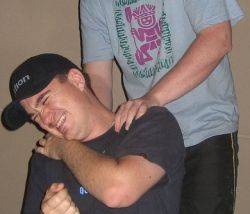- What Are the Most Important Massage Tools and Supplies and How to Buy them
- Benefits of Massage Therapy
- Massage Contraindications and Rules for Giving Massage
- Why Do We Need Massage – The Importance of Touch
- How To Create Massage Ambiance
- Nerve Strokes Massage Technique (Feathering)
- Tapotement or Percussion Massage Technique
- Effleurage – The Massage Technique
- The Importance of Touch
- Massage Contraindications
- How to Choose the Massage Oil
- How To Conclude a Massage session
- Massage Techniques Glossary
Things to avoid when you give a Massage
Massage is perceived as the most non-harmful medical practice and it is one of the most risk free medical procedures. However, there are situations when we should not give a massage or ask a physician’s opinion before doing it.
Conditions in which Massage Is Contraindicated
The massage is contraindicated in all the following situations:
Fever, inflammation, infectious diseases, hernia, osteoporosis, varicose veins, broken bones, skin problems, cancer, epilepsy, HIV infection.
During pregnancy – deep work should not be done, only light strokes.
For other conditions, a doctor should be consulted before giving a massage. These conditions are diabetes, asthma, recent surgery, and edema. For a more complete list, consult the massage contraindications page.
The “Do Not” of Massage
Danger Zones
- Front of the neck – It is obvious why; you aren’t trying to choke your patient. It’s a good idea to avoid at all this area.
- Side of the neck – Not as sensitive as the front of the neck, be very cautious when you massage this area, or avoid it.
- The “ear notch”: The notch behind the jawbone and beneath the ear it’s an extremely sensitive area. Do not shove a finger into this notch.
- The eyeball – Do not touch the person’s eyes. A light effleurage on the eyelids would be acceptable as it reduces the tension and it soothes the migraines.
- The armpit – It is a very sensitive area, with lots of nerves, arteries, and lymph glands.
- The upper inner arm – Just down from the armpit, along the inside of the upper arm, is a sensitive, nerve-filled area. Compressing here too firmly is unpleasant.
- The “funny bone – the exposed part, near the elbow of the ulnar nerve, it is a spot which, if you touch it too hard creates extreme discomfort.
- The abdomen: Be gentle around the superior portion of the abdomen along the ribs, where you find the liver, gall bladder, and spleen. You can however do some maneuvers if you are very careful.
- The lower back: Just below the ribs, both sides of the spine near the kidneys. Don’t press too hard or pound. Do not do tapotement on the kidneys.
- The groin: It’s the part where the leg meets the body. This part contains important blood vessels, lymph nodes, and nerves. Do not attempt any massage.
- Popliteal area (back of the knee): Always treat this place cautiously. It’s very sensitive to pressure.
First Rule – Do No Harm
The first and foremost rule of massage, as with any medical procedure, is “Primum non nocere”, which means – “First, do no harm”. If you’re not sure about a particular condition, do not give the massage.
- Neck pulling – Do not pull the head, like attempting to lengthen the neck, it is very dangerous.
- Neck twisting – No sudden movements! (You can do though some light stretching of the neck; very gentle and slow turnings of the neck are actually good.)
- Neck pulling and twisting together: Never ever, for any reason, pull and twist the neck at the same time. This is extremely dangerous.
- Bone cracking: Never, ever try to do a chiropractic-type adjustment if you haven’t been trained as a chiropractor. Do not touch the spine. You can work the muscles along the spine and this is extremely pleasurable and pain relieving. Don’t do compressions, (press), directly on bones.
- Over-extension – Don’t try to overstretch any articulation. Any articulation has its normal movement range; do not go over this limit. You need to use extreme caution when you do the stretching especially on the more sensitive areas as neck, arms, and hands.
Rules for Giving Massage
- Do no harm. This is the most important rule for a massage Therapist.
- Learn Anatomy – knowing the human body is a prerequisite.
- Use the good posture and use your entire body when you give a massage.
- Focus on your patient and get feedback to make the experience more effective and pleasurable.
- Take off jewelry, watches and all other items that might scratch the patient.
- The room to give the massage in has to be clean and tidy.
- Do not over or under lubricate the patient the skin will tell you if it can absorb more oil.
- Put a pillow, or a rolled towel under the patient’s ankles.
- Never take your hands off the patient after you start the massage.
- Always massage a muscle that is relaxed.
- Never cross the spine with pressure when you are giving the massage.
- Massage on the opposite side that you’re working on when you are doing friction.
- Use gentle steady pressure and gradually increase it.
- Use good posture while giving the massage.
- Always remember to get feedback from the patient.
- Massage in the direction of blood circulation, toward the heart
- If you are not using oil do not friction the skin the hand has to maintain firm contact with the skin while massaging the deeper tissue.
- Cleanliness first – Be clean, take a shower whenever appropriate, wash your hands, have your nails trimmed, have a good looking appearance.
- Do not use cold hands (if necessary warm hands with warm water) rub your hands together before any session for 20-30 seconds.
